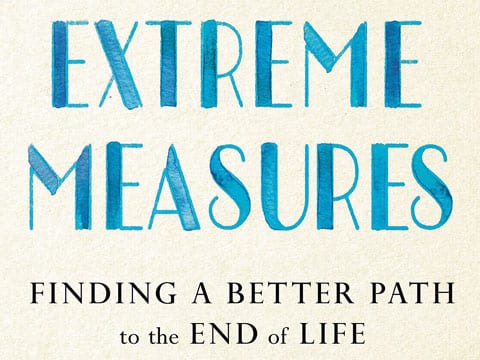Published on October 18, 2018

Jessica Nutik Zitter, MD, will be the keynote speaker at this year’s Alive Symposium on Family, Health, and Spirituality.
She became a doctor because she wanted to be a hero, rescuing patients from the brink of death. But over time, she came to a new understanding of what heroism is really all about.
Her book Extreme Measures charts her two-decade journey through intensive care units. Dr. Zitter was dismayed to see how the dying are treated in our current medical culture, where mechanization and protocol override patient-centered care.
This led her to the burgeoning palliative care movement, which focuses on the overall well-being of the patient, rather than just the disease.
Excerpt from Chapter Four of Extreme Measures, “The Illusion Collusion”
Walter Miller had put together an “A team” to cure his cancer, but it was actually killing him.
On my first day of vacation a few summers ago, I was driving on the Long Island Expressway toward New Jersey with my family when I received a frantic phone call. Given my reputation among friends and family as an expert on death and dying, as well as my poor ability to set limits, I often receive panicked calls on behalf of someone’s loved one.“Jessica, you need to talk to my friend’s wife. He’s really sick, and she’s not sure what to do. Can I patch her into the call? Listen, he’s a real fighter. Don’t mention death or dying. Talk your ICU talk.”
I recognized a familiar trope. “All right, put her on,” I said, as I flew by the first in a series of missed exits to New Jersey. For the next 90 minutes my husband held the phone to my ear as I tried to get us to our destination.Walter was a 70-year-old man, wealthy and powerful, a pillar of the community. He had been diagnosed with pancreatic cancer six months earlier and was in the throes of an aggressive treatment plan at a highly respected New York hospital. His wife, in a panic, reported to me that he was vomiting, delirious, and moaning in pain. It was Saturday night and his doctor wasn’t available, she said. Walter was due for his next round of chemotherapy Monday morning.
I took a deep breath. This man sounded too sick to turn over in bed, let alone take an hour-long car ride to a chemotherapy appointment. I suggested to his wife that she take him to their local emergency room for symptom management. She refused. “Walter wants his ‘A team’ at Columbia Prez.” She made Columbia Presbyterian Hospital sound like the Ritz. You’ve heard of Dr. B?”
I hadn’t, which made her nervous, and she tossed in a few other names from the elite fighting unit they had assembled. “Well, they’re the best, the most aggressive. That’s what Walter wants. My son-in-law knows the CEO of MD Anderson and he told us they’re the best. If I take him to the ER here, they’ll admit him, and then we’ll be stuck in New Jersey. We can’t get the chemotherapy if he doesn’t go into the city.”
I asked her if there was a palliative care physician on their team to manage his symptoms, which the American Society of Clinical Oncology recommends as standard protocol for anybody with metastatic cancer and/or a high symptom burden. The brutal treatment regimens demand aggressive pain management, as any “A team” would surely know. “Walter isn’t ready for that. He really wants to fight,” she said. “Palliative care means you’re giving up. Dr. B says we’re not there yet.”
This man’s fate unfolded in front of my eyes. I saw paramedics and emergency rooms, with an eventual admission to an ICU. Like a panicked swimmer fighting to stay above the waves, Walter would muster any remaining strength for more of the treatments he assumed were helping him. When he finally tired, his family would carry on fighting in keeping with his plans. Then he would be put on life support until he died.
Walter was being treated to death. The more I learned of his case, the clearer it became: His cancer was deadly from the beginning, a tangled web of spidery tissue emanating from his pancreas and melting through the surrounding tissue planes. This was not surgically treatable, and chemotherapy would more likely be burdensome than helpful. Yet the family had hunkered down with their “A team” in the swankiest hospital in the New York metropolitan area to fight. And they had fought. As Walter continued to deteriorate, he kept asking for more. And there was always more—there always is. More appointments, more chemotherapy, more promises. Ask and ye shall receive.
By this point I had missed my third exit. My husband’s arm was numb from holding the phone and the children in the back were cranky and tired. I had been asked to call the next play in a doomed game. And the “A team” was nowhere to be found.
Partly out of sheer exhaustion, I told Walter’s wife the simple truth. “Your husband is dying,” I said. There was a stunned silence on the other end of the line. I explained that Walter had very little time left. The disease had not responded to Herculean efforts and it wouldn’t start now.
But then I began to tell her of all that we could do that would actually help him. His symptoms, which had been building for weeks, could be tamed, even eliminated. Palliative care teams bat 90 percent at conquering most of the symptoms that accompany life-limiting illnesses such as pain, nausea, vomiting, delirium, and existential angst, to name just a few. The typical “A team,” while busy fighting cancer, leaves the patient alone with his severe symptoms. Anything less than curing cancer seems like child’s play. But the data show that cancer patients receiving excellent palliative care live on average two months longer than those who continue disease-directed treatments alone.
Printed with permission of Avery, an imprint of Penguin Random House.
Visit her site to learn more: jessicazitter.com/extreme-measures
